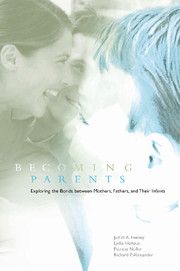Book contents
- Frontmatter
- Contents
- Preface
- 1 The Transition to Parenthood
- 2 Attachment in Childhood and Beyond
- 3 The Study
- 4 The Couples
- 5 Pregnancy and Plans for Birth
- 6 Couples' Experiences of Birth and New Parenthood
- 7 How Does New Parenthood Affect Couples?
- 8 Dealing with Depression
- 9 Men, Women, and Household Work: The Diaries
- 10 Couples' Changing Attachment Relationships
- 11 Six Months into Parenting
- 12 New Parenthood in Perspective
- Appendix A Core Questionnaires Completed by Couples
- Appendix B Summary of Sample Characteristics
- Appendix C Summary of Major Statistical Analyses
- References
- Author Index
- Subject Index
2 - Attachment in Childhood and Beyond
Published online by Cambridge University Press: 05 June 2012
- Frontmatter
- Contents
- Preface
- 1 The Transition to Parenthood
- 2 Attachment in Childhood and Beyond
- 3 The Study
- 4 The Couples
- 5 Pregnancy and Plans for Birth
- 6 Couples' Experiences of Birth and New Parenthood
- 7 How Does New Parenthood Affect Couples?
- 8 Dealing with Depression
- 9 Men, Women, and Household Work: The Diaries
- 10 Couples' Changing Attachment Relationships
- 11 Six Months into Parenting
- 12 New Parenthood in Perspective
- Appendix A Core Questionnaires Completed by Couples
- Appendix B Summary of Sample Characteristics
- Appendix C Summary of Major Statistical Analyses
- References
- Author Index
- Subject Index
Summary
The concept of attachment has had a central place in the literature on parent–child relationships for several decades. Most experts in this area would agree that a secure attachment bond with at least one nurturing adult is a key factor in producing happy and well-adjusted children. It seems that these bonds help children develop feelings of trust and confidence, enabling them to move out into the world and acquire the skills they need to deal with new situations. Similarly, recent research suggests that attachment is a useful concept for understanding the bonds that adults form with intimate partners, and the way that couples respond to stress and change. But how can attachment be defined?
DEFINING ATTACHMENT
In everyday language, it is common for people to talk about being “attached” to someone or something. According to the Concise Oxford Dictionary, this everyday use of the term attachment refers to feelings of affection and devotion. In writings on religious and philosophical topics, however, the term attachment often implies something more than this: a very strong desire to have or to keep the object of affection, and conversely, an extreme reluctance to give up the object, or do without it.
In all these respects, researchers' use of the term attachment is similar to the use in everyday language. The best-known figure in this area of research has been John Bowlby, an English scholar who studied and wrote about childhood attachment from the 1940s through to the 1980s.
- Type
- Chapter
- Information
- Becoming ParentsExploring the Bonds between Mothers, Fathers, and their Infants, pp. 22 - 47Publisher: Cambridge University PressPrint publication year: 2001



